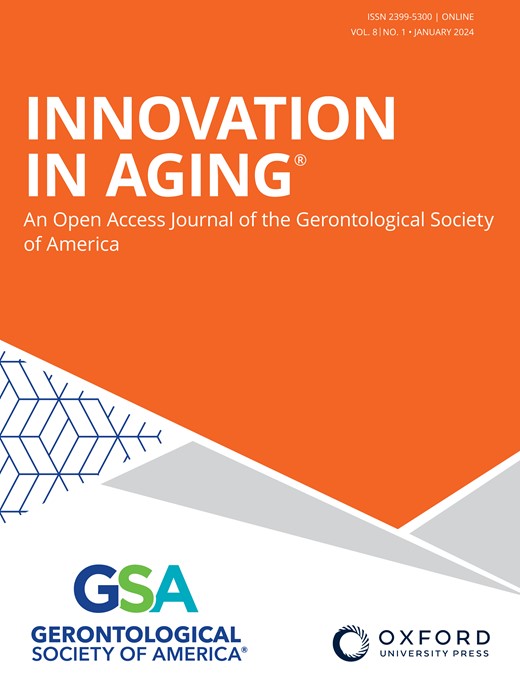COMPARISON OF STEREOLOGY METHODS FOR ASSESSING AGE-RELATED EFFECTS ON IMMUNOSTAINED BRAIN CELLS
IF 4.9
3区 医学
Q1 GERIATRICS & GERONTOLOGY
引用次数: 0
Abstract
Abstract The primary benefit of stereology methods is quantification of well-stained biological objects in tissue sections with the ability to adjust sampling intensity to achieve desired levels of precision. The advent of hand-crafted algorithms and artificial intelligence-based deep learning (DL) provides an opportunity for more standardized collection of stereology data with enhanced efficiency and higher reproducibility compared to state-of-the-art manual stereology. We contrasted and compared the performance of four manual, semi-automatic, and fully automatic approaches for generating data for total number of Neu-N immunostained neurons in neocortex (NCTX) in the mouse brain. The gold standard for these studies was manual counts using the state-of-the-art optical fractionator method on 3-D reconstructed serial z-axis image stacks through a known tissue volume (disector stacks). To allow for direct methodological comparisons on the same images, disector stacks were automatically converted into extended depth of field (EDF) images in which all neurons in the disector stack were imaged at each cell’s maximal plane of focus. Total number of Neu-N neurons on the same EDF images were counted by a fully automatic hand-crafted method [automatic segmentation algorithm (ASA)] and a semi-automatic method [ASA counts manually corrected for false positives and negatives]. All comparison counts were done using unbiased frames and counting rules with total counts of NeuN-immunostained neurons by the optical fractionator method. The results were comparable across methods with wide variations in throughput efficiency and inter-rater agreement. These results are discussed with respect to applications to experimental studies of brain aging, neuroinflammation and neurodegenerative disease.比较立体学方法,评估年龄对免疫染色脑细胞的影响
摘要 立体学方法的主要优点是对组织切片中染色良好的生物物体进行量化,并能调整采样强度以达到所需的精度水平。手工制作的算法和基于人工智能的深度学习(DL)的出现为更标准化地收集立体学数据提供了机会,与最先进的手工立体学相比,这种方法具有更高的效率和可重复性。我们对比了四种手动、半自动和全自动方法在生成小鼠大脑新皮质(NCTX)中 Neu-N 免疫染色神经元总数数据方面的性能。这些研究的金标准是使用最先进的光学分型器方法,通过已知组织体积(disector stacks)在三维重建的序列 Z 轴图像堆栈上进行人工计数。为了在相同的图像上进行直接的方法学比较,Disector 堆叠图像被自动转换成扩展景深(EDF)图像,其中 Disector 堆叠中的所有神经元都在每个细胞的最大聚焦平面上成像。采用全自动手工方法[自动分割算法(ASA)]和半自动方法[人工校正假阳性和假阴性的 ASA 计数]计算同一张 EDF 图像上 Neu-N 神经元的总数。所有比较计数均采用无偏见框架和计数规则,并与光学分馏器法的 NeuN 免疫染色神经元总计数进行比较。不同方法的结果具有可比性,但通量效率和评分者之间的一致性差异很大。本文讨论了这些结果在脑衰老、神经炎症和神经退行性疾病实验研究中的应用。
本文章由计算机程序翻译,如有差异,请以英文原文为准。
求助全文
约1分钟内获得全文
求助全文
来源期刊

Innovation in Aging
GERIATRICS & GERONTOLOGY-
CiteScore
4.10
自引率
0.00%
发文量
72
审稿时长
15 weeks
期刊介绍:
Innovation in Aging, an interdisciplinary Open Access journal of the Gerontological Society of America (GSA), is dedicated to publishing innovative, conceptually robust, and methodologically rigorous research focused on aging and the life course. The journal aims to present studies with the potential to significantly enhance the health, functionality, and overall well-being of older adults by translating scientific insights into practical applications. Research published in the journal spans a variety of settings, including community, clinical, and laboratory contexts, with a clear emphasis on issues that are directly pertinent to aging and the dynamics of life over time. The content of the journal mirrors the diverse research interests of GSA members and encompasses a range of study types. These include the validation of new conceptual or theoretical models, assessments of factors impacting the health and well-being of older adults, evaluations of interventions and policies, the implementation of groundbreaking research methodologies, interdisciplinary research that adapts concepts and methods from other fields to aging studies, and the use of modeling and simulations to understand factors and processes influencing aging outcomes. The journal welcomes contributions from scholars across various disciplines, such as technology, engineering, architecture, economics, business, law, political science, public policy, education, public health, social and psychological sciences, biomedical and health sciences, and the humanities and arts, reflecting a holistic approach to advancing knowledge in gerontology.
 求助内容:
求助内容: 应助结果提醒方式:
应助结果提醒方式:


